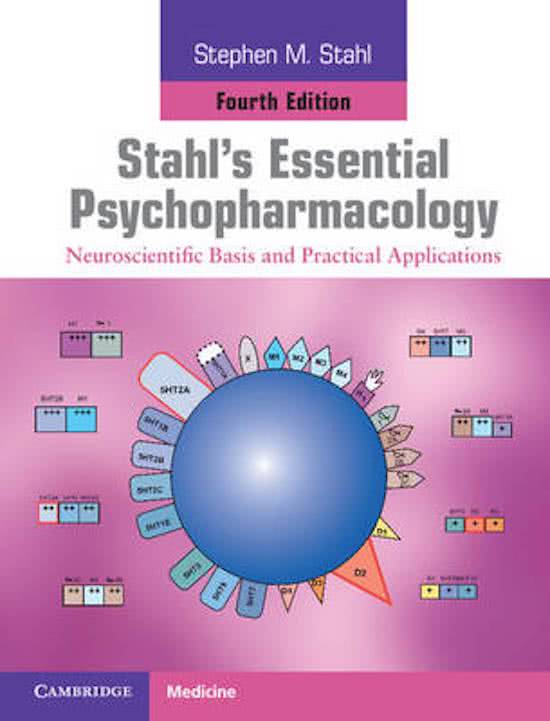Content
Questions……………………………………………………………………………………...2
Week 1…………………………………………………………………………………………2
Week 2………………………………………………………………………………………..12
Week 3………………………………………………………………………………………..22
Questions and answers……………………………………………………………………...31
Week 1………………………………………………………………………………………..31
Week 2………………………………………………………………………………………..41
Week 3………………………………………………………………………………………..51
1
,Questions
Week 1
1. What is the anatomical basis of neurotransmission?
Neurons and synapses.
2. What kind of process is neurotransmission?
A chemical process.
3. What are the six most important neurotransmitters?
• Serotonin (5HT).
• Norepinephrine (NE).
• Dopamine (DA).
• Acetylcholine (ACh).
• Glutamate.
• GABA.
4. Which three neurotransmitters are classified as monoamines?
• Serotonin.
• Norepinephrine.
• Dopamine.
5. Which neurotransmitter is classified as an amine?
Acetylcholine.
6. Which neurotransmitters are classified as amino acids?
Glutamate and GABA.
7. Which seven types of special neurons exist?
• Pyramidal neurons.
• Chandelier neurons.
• Spiny neurons.
• Purkinje cells.
• Interneurons.
o Basket cells.
o Double bouquet cells.
8. Describe pyramidal neurons.
These have a triangular cell body, one axon, and are generally stimulating. They can be
found in the prefrontal cortex, hippocampus, and entorhinal cortex. Pyramidal neurons
are involved in executive function and memory.
2
,9. Describe chandelier neurons.
They look like chandeliers, have axoaxonic connections, and have inhibiting effects on
pyramidal cells. They can be found in the cortex.
10. Describe spiny neurons.
They have dendrites shaped like spikes, long axons, and can be found in the striatum.
11. Describe purkinje cells.
They have dendrites shaped like a tree, one axon, and can be found in the cerebellum.
12. Describe interneurons.
There are two types of interneurons; local (short axons that analyse small pieces of
information) and relay (long axons that travel over brain regions). Interneurons
provide a connection between sensory and motor neurons.
13. Describe basket cells.
They are inhibitory interneurons that can be found in the cortex. They have dendrites
shaped like a basket.
14. Describe double bouquet cells.
They are inhibitory interneurons that can be found in the cortex. They have dendrites
shaped like two bouquets.
15. Label these (you can skip 10 and 13):
1. Nucleolus. 9. Mitochondrion.
2. Nucleus. 10. Vacuole (not important for the
3. Ribosome. exam).
4. Vesicle. 11. Cytoplasm.
5. Rough endoplasmic reticulum (ER). 12. Lysosome.
6. Golgi apparatus. 13. Centrioles/centrosome.
7. Cytoskeleton. 14. Membrane.
8. Smooth ER.
3
, 16. Neuronal transport includes all transport that occurs within the neuron. What is meant by
slow transport?
Slow transport (2 mm per day) includes the transport of proteins from the cytoplasm to
the axon and dendrites.
17. Neuronal transport includes all transport that occurs within the neuron. What is meant by
fast transport?
Fast transport (200 mm per day) includes the transport of vesicles containing
neurotransmitters, peptides, receptors, enzymes, ion channels, and transport pumps.
18. Neuronal transport includes all transport that occurs within the neuron. What is meant by
anterograde transport?
Soma → axon.
19. Neuronal transport includes all transport that occurs within the neuron. What is meant by
retrograde transport?
Axon → soma.
20. A developing brain of a foetus contains many neurons. Before birth, 90% of these go
through apoptosis. What is apoptosis?
Apoptosis is a normal and healthy process in which unwanted, damaged, and old
neurons ‘kill themselves’.
21. What is necrosis?
This is an inflammatory (unhealthy) response that leads to neuronal degradation.
22. What is excitation-secretion coupling?
In classic neurotransmission, an electrical signal moves through a neuron, and this
neuron sends a neurotransmitter to the next neuron. The electrical signal is converted
into a chemical signal. This process is called excitation-secretion coupling and is the first
stage of chemical neurotransmission. Communication within a neuron is electrical,
while communication between neurons is chemical.
23. What is retrograde neurotransmission?
Retrograde neurotransmission occurs when the postsynaptic neurons ‘talks back’ to the
presynaptic neuron. Some chemicals are produced specifically as retrograde
neurotransmitters. Examples are endocannabinoids, nitric oxide, and neurotrophic
factors such as nerve growth factor.
24. What is volume neurotransmission?
Neurotransmission can also take place without a synapse. This is called volume
neurotransmission. By diffusing, the neurotransmitters sent by the presynaptic neuron
can reach receptors outside the synapse.
4






